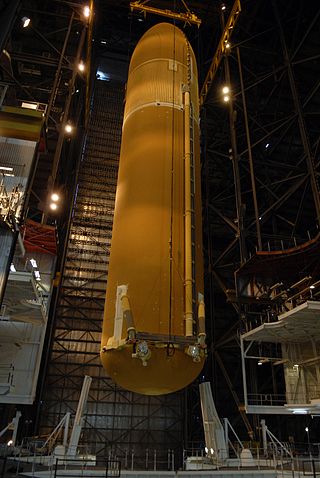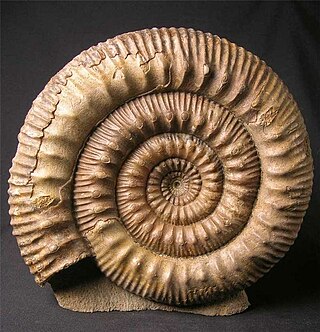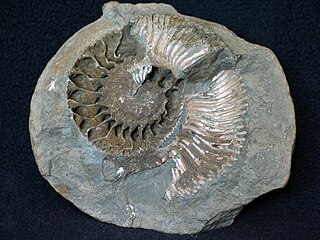
The Space Shuttle external tank (ET) was the component of the Space Shuttle launch vehicle that contained the liquid hydrogen fuel and liquid oxygen oxidizer. During lift-off and ascent it supplied the fuel and oxidizer under pressure to the three RS-25 main engines in the orbiter. The ET was jettisoned just over 10 seconds after main engine cut-off (MECO) and it re-entered the Earth's atmosphere. Unlike the Solid Rocket Boosters, external tanks were not re-used. They broke up before impact in the Indian Ocean, away from shipping lanes and were not recovered.

Stephanoceras is an extinct genus of Stephanoceratoid ammonite which lived during the Bajocian. It is the type genus of the family Stephanoceratidae.

Aulacostephanus is an extinct ammonoid cephalopod genus from the Upper Jurassic Tithonian belonging to the perisphinctoidean family Aulacostephanidae.
Aplococeras is an evolute discoidal ceratitid ammonite from the Middle Triassic Ladinian stage, found in southern Europe and Nevada. Whorl sides are convex, converging on a rounded venter, and are ornamented with slightly flexuous umbilical ribs that disappear outwardly, towards the venter. The suture has two lateral lobes.
Arkanites is a goniatitid ammonite that lived during the Early Pennsylvanian that has been found in Arkansas and Oklahoma in the U.S.
Frenguelliceras is an ammonite genus from the Lower Cretaceous included in the perisphinctoid family Neocomitidae named by Leanza in 1945. The type species, F. magister, is from the Valanginian,(Lower Cretaceous), of Argentina.
Frechites is an early Triassic ammonite, a kind of cephalopod with an external shell, included in the ceratitid family Beyrichitidae.
Zurcherella is a Lower Cretaceous (Upper Barremian - Upper Aptian desmoceratid ammonite from France and Colombia. Its shell is moderately compressed and rather involute, with fine sinuous ribs that arise some distance above the umbilical rim. Zurcherella differs from its descendant Uhligella in that in the latter, ribs arise from the umbilical shoulder.

Ammonitina comprises a diverse suborder of ammonite cephalopods that lived during the Jurassic and Cretaceous periods of the Mesozoic Era. They are excellent index fossils, and it is often possible to link the rock layer in which they are found to specific geological time periods.
Syringonautilidae is a family of Nautiloidea from the middle to late Triassic. Syringonautilidae comprise the last of the Trigonoceratoidea and are the source for the Nautilaceae which continued the Nautiloidea through the Mesozoic and into the Cenozoic right down to the recent. Syringonautilidae is a strictly Triassic family, derived early in the Triassic from the Grypoceratidae.

Grypoceratidae is the longest-lived family of the Trigonoceratoidea, or of the near equivalent Centroceratina; members of the Nautilida from the Upper Paleozoic and Triassic.
Otoidtidae: stephanoceratoid ammonitina from the early Middle Jurassic that begin as cadicones but become more planualte with age; derived from the Hammitoceratidae (Hildoceratoidea), probably through Erycites by way of Abbasites.

Forresteria is an extinct genus of cephalopod belonging to the subclass Ammonoidea. They flourished during the late Turonian and early Coniacian of the Late Cretaceous, and were global in extent. Forresteria alluaudi and Forresteria hobsoni are considered marker fossils for the lower Coniacian in the American West.
Encoiloceras is a genus of Tainoceratids, a nautiloid cephalopod in the order Nautilida that has been found in Upper Triassic (Carnian) sediments in the Alps and Hungary.
Doulingoceras is a genus of ammonoid within the ceratitid order, found in China, that lived during the Late Permian during the time span from about 260.5 to 254 million years ago. The genus is included in the family Paraceltitidae, which belongs to the superfamily Xenodiscaceae.
Flabellisphinctes is small, evolute ammonite genus from the upper Middle Jurassic (Callovian) that lived between 160 and 154 Ma ago.
Pseudohaploceras is a genus of desmosceratid ammonites from the Early Cretaceous; Valanginian to Albian epochs.
Dasyceras is an early phylloceratid from the Sinemurian stage of the lower Jurassic, found in Europe.
Neocardioceras is a genus of evolute acanthoceratid ammonites from the uppermost Cenomanian, Upper Cretaceous, of Europe, western U.S. and Brazil.

Quenstedtoceras is a genus of ammonoid cephalopods that lived during the latter part of the Jurassic period in what is now France, Poland, Germany, and the United Kingdom.






